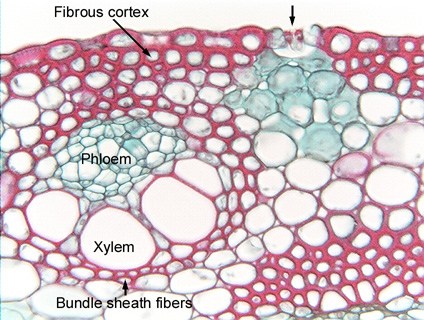 Fig.
10.3-9. Transverse section of corn stem (Zea mays). Stems of
corn, like those of many monocots, have a very fibrous construction. Here, the
vascular bundles are enclosed by bundle sheath fibers and the outermost cortex
consists of several layers of fibers. Most fiber tissue is compact, with few or
no intercellular spaces, which inhibits the diffusion of gases. Notice that
the band of fibers in the outer cortex is interrupted near the stoma:
just below the stoma is a mass of blue-stained parenchyma cells with
intercellular spaces. It is not quite open enough to call it an
aerenchyma, but it does permit carbon dioxide to pass through the epidermis and
be absorbed by the chlorenchyma in the cortex.
Fig.
10.3-9. Transverse section of corn stem (Zea mays). Stems of
corn, like those of many monocots, have a very fibrous construction. Here, the
vascular bundles are enclosed by bundle sheath fibers and the outermost cortex
consists of several layers of fibers. Most fiber tissue is compact, with few or
no intercellular spaces, which inhibits the diffusion of gases. Notice that
the band of fibers in the outer cortex is interrupted near the stoma:
just below the stoma is a mass of blue-stained parenchyma cells with
intercellular spaces. It is not quite open enough to call it an
aerenchyma, but it does permit carbon dioxide to pass through the epidermis and
be absorbed by the chlorenchyma in the cortex.